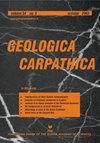Tectonic inversion of Late Miocene extensional deformations in northeastern Tunisia (Cap Bon Peninsula–Sahel area)
IF 1.5
4区 地球科学
Q4 GEOSCIENCES, MULTIDISCIPLINARY
引用次数: 0
Abstract
: The tectonic inversion of the Miocene extensional basins (Cap Bon Peninsula–Sahel area, northeastern Tunisia) is an important process that accommodates the crustal shortening in the northeastern Tunisian edge with the ongoing collision between the African and European plates. Field observations and microtectonic measurements have revealed two main Late Miocene tectonic events: (1) A NE–SW trending extensional tectonic event that would create titled blocks, horsts, and grabens, as well as slump features. These structures were controlled by numerous conjugate systems of syndepositional normal faults. On a regional scale, the NW-trending faults controlled the Miocene sedimentation and subsidence rate in the Takelsa, Dakhla, Saouaf, and Zeramdine syn-rift grabens and (2) the NW-directed post-Tortonian compression, the so-called “Alpine/Atlasic event” that was identified by NE–SW-oriented reverse slip movements and associated folds. The latter compressional event began in the latest Miocene and continued through the Plio–Quaternary, which thus led to the complete inversion of the Miocene basins by the ongoing African and European plates’ convergence. A significant neotectonic uplift of the Abderrahmane, Korbus, and Skanes areas recorded the switch from Late Miocene crustal extension to post-Tortonian to Quaternary compressional tectonics. In fact, the present-day petroleum trap configuration of the northeastern offshore Tunisia is highly controlled to the Miocene–Quaternary tectonic inversion. The sandy levels along the thick Tortonian section provided the most preferred target for petroleum exploration. They exhibit considerable variations in thickness controlled by Late Miocene to Quaternary tectonic trends.突尼斯东北部晚中新世伸展变形的构造反转(Cap Bon半岛-萨赫勒地区)
:中新世伸展盆地(Cap Bon半岛-萨赫勒地区,突尼斯东北部)的构造反转是一个重要过程,它适应了突尼斯东北部边缘的地壳缩短以及非洲和欧洲板块之间的持续碰撞。现场观测和微构造测量揭示了两个主要的中新世晚期构造事件:(1)NE–SW走向的伸展构造事件,该事件将产生标题地块、地垒和地堑,以及坍落特征。这些构造受同沉积正断层的许多共轭系统控制。在区域范围内,北西向断层控制了Takelsa、Dakhla、Saouaf和Zeramdine同裂谷地堑的中新世沉积和沉降速率,以及(2)北西向的后托托期挤压,即所谓的“阿尔卑斯/Atasic事件”,由北东-西南向的反向滑动运动和相关褶皱确定。后一次挤压事件始于最近的中新世,并一直持续到上新世-第四纪,因此,非洲和欧洲板块的交汇导致了中新世盆地的完全反转。Abderrahmane、Korbus和Skanes地区的一次重要的新构造抬升记录了从中新世晚期地壳伸展到托托尼亚后到第四纪挤压构造的转变。事实上,突尼斯东北部近海现今的石油圈闭构造高度受控于中新世-第四纪构造反转。托尔顿阶厚段沿线的沙质水平面为石油勘探提供了最优选的目标。它们在厚度上表现出相当大的变化,受中新世晚期至第四纪构造趋势的控制。
本文章由计算机程序翻译,如有差异,请以英文原文为准。
求助全文
约1分钟内获得全文
求助全文
来源期刊

Geologica Carpathica
地学-地球科学综合
CiteScore
2.40
自引率
23.10%
发文量
26
审稿时长
>12 weeks
期刊介绍:
GEOLOGICA CARPATHICA covers a wide spectrum of geological disciplines including geodynamics, tectonics and structural geology, volcanology, stratigraphy, geochronology and isotopic geology, karstology, geochemistry, mineralogy, petrology, lithology and sedimentology, paleogeography, paleoecology, paleobiology and paleontology, paleomagnetism, magnetostratigraphy and other branches of applied geophysics, economic and environmental geology, experimental and theoretical geoscientific studies. Geologica Carpathica , with its 60 year old tradition, presents high-quality research papers devoted to all aspects not only of the Alpine-Carpathian-Balkanian geoscience but also with adjacent regions originated from the Mediterranean Tethys and its continental foreland. Geologica Carpathica is an Official Journal of the Carpathian-Balkan Geological Association.
 求助内容:
求助内容: 应助结果提醒方式:
应助结果提醒方式:


